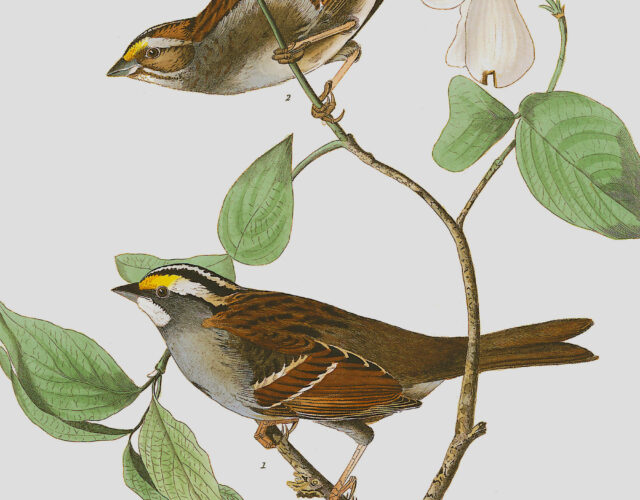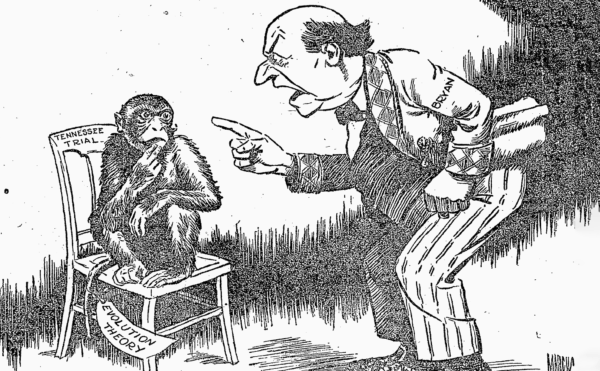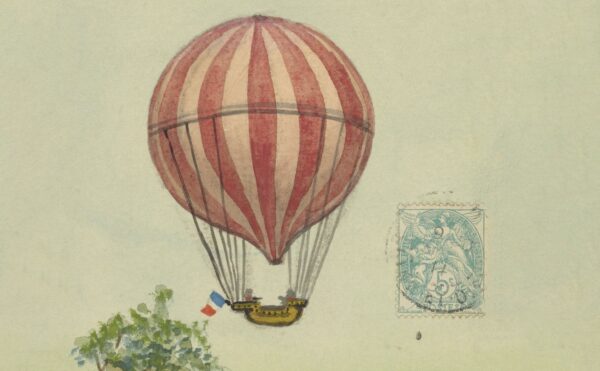When scientists Elaina Tuttle and Rusty Gonser sequenced the chromosomes of the white-throated sparrow, they noticed something funny—and something that would help explain why the bird had four sexes.
About The Disappearing Spoon
The Science History Institute has teamed up with New York Times best-selling author Sam Kean to bring a second history of science podcast to our listeners. The Disappearing Spoon tells little-known stories from our scientific past—from the shocking way the smallpox vaccine was transported around the world to why we don’t have a birth control pill for men. These topsy-turvy science tales, some of which have never made it into history books, are surprisingly powerful and insightful.
Credits
Host: Sam Kean
Senior Producer: Mariel Carr
Producer: Rigoberto Hernandez
Associate Producer: Padmini Raghunath
Audio Engineer: Jonathan Pfeffer
Transcript
The novel Slaughterhouse-5 includes a strange conversation about sex. During it, an alien tells a human that, on its planet, they have five separate and unique biological sexes.
This baroque system blows the human’s mind. He grew up thinking about only two sexes, male and female. The thought of five staggers him.
Well, what if I told you that biologists have recently discovered a species similar to the alien system? And not on some distant planet, but right here on Earth. It’s not humans, although we’ll get to that. It’s a type of bird with four separate sexes.
Fittingly enough, this discovery was made by a husband-and-wife team—two biologists who had their own sad love story. But during their last years together, they managed to unravel these birds’ secret sex life—and demonstrate why birds, and human beings, even have different sexes in the first place.
From the Science History Institute this is Sam Kean and the Disappearing Spoon—a topsy-turvy science-y history podcast. Where footnotes become the real story.
The bird in question is the white-throated sparrow. Here’s its chirp… <CHIRPING> Some birders describe this melody as “Oh, sweet Canada, Canada, Canada.” Others hear, “Oh, sweet, Kimberly, Kimberly, Kimberly.” <CHIRPING>
Regardless, if you’ve ever been to Canada, or the United States, you’ve almost certainly seen one in a backyard somewhere. It’s quite common.
But it probably didn’t make an impression. That’s because the white-throated sparrow is pretty blah. It’s short and plump. And while it has a nice touch of yellow around the eyes, it’s mostly brown and grey. Pretty drab.
Still, there is one feature you should pay attention to the next time you see one—the feathers on the head. Some of these sparrows have dull tan stripes on their head, while some have more flamboyant white stripes.
And when biologists looked closer, they noticed something strange: The mating among the birds was very particular. In over 99 percent of cases, tan-striped birds would mate only with white-striped ones. You almost never have tan-tan or white-white couplings. Opposites attract.
Now, there’s no perfect definition of biological sex, but one definition involves what proportion of the population a typical individual can and will reproduce with. In virtually all animal species, that’s ½, or one over two. Which is why we have two sexes.
But in white-throated sparrows, there are tan-headed males, tan-headed females, white-headed males, and white-headed females. And each group reproduces with only ¼ of the population, or one over four. In other words, there are four separate sexes.
Why, though? Why does this one animal defy the normal rules? No one knew, until Elaina Tuttle came along.
Tuttle grew up in Massachusetts in the 1960s. She was one of those kids who was always splashing around in ponds and streams, knee-deep in muck. She ended up going to graduate school in ecology in upstate New York.
While in school, she met a fellow graduate student named Rusty Gonser. They soon fell in love and got married in 1994.
Eventually Tuttle and Gonser both became professors at Indiana State University, where they shared an office. But something about upstate New York kept tugging them back. Each summer they’d pack the car and drive to Cranberry Lake near the Canadian border. The trip took 13 hours, and reaching their cabin then required a 45-minute boat ride after that.
But the isolation didn’t bother them. By day, they studied the white-throated sparrows near Cranberry Lake, trudging through the woods. Then they spent quiet nights alone on the water. They returned to idyllic Cranberry Lake every summer for a quarter-century.
Eventually, they tackled the big puzzle of the white-throated sparrow: why the flamboyant white-striped ones mated only with the dull tan-striped ones. What was going on?
Luckily, DNA sequencing took off in the early 2000s, which allowed Tuttle and Gonser to peek at the sparrow’s chromosomes.
Chromosomes are long strings of DNA inside cells that contain genes. Usually few hundred genes to a few thousand.
Importantly, animals have pairs of analogous chromosomes. For instance, humans have 23 pairs. There’s two chromosome number 1s, two chromosome number 2s, two chromosome number 3s, and so on. White-throated sparrows have over 40 pairs, or 80-some chromosomes.
This count includes the sex chromosomes. In mammals, males are usually XY and females XX. Birds have a similar system, except with chromosomes called Z and W.
Now, to get DNA to study, Tuttle and Gonser harvested sparrow sperm, which is rich in DNA. As for how they got sparrow sperm—well, as Gonser once said, with pride: My wife “was the best bird masturbator I ever met.” How could you not love a woman like that?
Regardless, when Tuttle and Gonser sequenced the chromosomes of the white-throated sparrows, they noticed something funny. Part of chromosome 2 in the birds had been inverted. That is, flipped around.
In most birds, the genes on chromosome 2 are arranged in a certain order. Let’s call them gene A, gene B, gene C, and so on. But in these sparrows, the alphabet ran backwards at one point. Instead of L, M, N, O, P, it went P, O, N, M, L.
Now, inversions like this do happen in chromosomes sometimes, even in humans. But the inversion in the sparrow was on a whole ‘nother scale. Usually just a few genes get inverted. In this case, over a thousand got flipped—a massive inversion.
This turned out to be a big clue to the mystery of why the sparrows had four sexes. Unfortunately, just as they found this clue, tragedy struck.
One day in 2011, Tuttle scheduled a routine mammogram. She walked into the clinic a seemingly healthy woman—and walked out with breast cancer. It completely blindsided her.
But she fought through it. She got a mastectomy and started chemotherapy. And she refused to stop doing science. She kept making the thirteen-hour drive to Cranberry Lake in between chemotherapy sessions. And after a year of struggle, the cancer went into remission. Her body was clear.
All the while, she and Gonser kept working on the sparrow. Remember, they had that one big clue—the inverted genes on chromosome 2. But what did it mean?
This was actually a problem with many DNA studies then. Scientists had gobs and gobs of data. And they initially thought that the gobs of data would instantly correlate to, say, cures for diseases or other biological insights.
The problem is, genetic data tells you very little by itself. You still have to correlate that DNA data with clinical disease symptoms or behavior in the real world. It’s hard work.
Lucky for them, Tuttle and Gonser had been studying the white-throated sparrows for a quarter-century—making detailed observations. So they could indeed correlate that odd inverted DNA with actual behaviors in the wild.
As I mentioned, some of these sparrows had flamboyant white head-stripes. And it turns out that the white-striped ones engage in flamboyant behavior as well.
For one thing, white-striped ones sing more often, and they sing more loudly. <CHIRP> For another, white-striped males and females are both super-aggressive about defending their territory. If another bird flits by, watch out, punk—they go right after them.
Moreover, flamboyant white-striped birds are promiscuous. They cheat on their spouses all the time. White-stripes are also lousy parents. When their eggs hatch, they rarely bother feeding the chicks. That flamboyance has a downside.
Meanwhile, the dull, tan-striped sparrows are in fact kind of dull personally, too. They’re quiet, stay-at-home types who rarely sing. And they don’t say squat when their white-striped spouses are out picking fights and cruising for sex.
All that said, the tan-stripes do take much better care of their chicks, and actually take the time to feed them. So each variety, tan-stripe and white-stripe, has pluses and minuses.
In fact, those complementary behaviors explained the birds’ odd mating system. Flamboyant white-stripes would flame out as a couple because they’re too alike. They’d cheat and fight and never feed their chicks. But a couple consisting of two tan-stripes wouldn’t function, either. Being stay-at-home types, they probably wouldn’t meet up. And they’re terrible at defending their territory from other birds or ranging for food in hard times.
Overall, then, having one aggressive white-stripe and one meek tan-stripe makes a good, balanced couple. It’s like those human couples where one person is an impulsive, spendthrift socialite and the other a quiet, contemplative wallflower. Their strengths and weaknesses complement each other.
And here’s where everything came together, the DNA work and the behavioral studies. Because Tuttle and Gonser realized that those different behaviors among tan-stripes and white-stripes seem to spring directly from the inversion on chromosome 2.
That chromosome happens to contain two genes, one that controls head-stripe color, and one that influences how aggressive birds are. Apparently, both got mutated way back when, which led to birds that were both flamboyant and white-headed. And because they were both on the same chromosome, those genes tended to get inherited together.
But mother nature does have a way to mix up genes. I’m not going to go into all the details, but this occurs through a process called crossing-over. It takes place when the body makes sperm and egg cells.
To understand crossing-over, picture a pair of chromosomes. One is blue, one is red. Now, they’re not blue and red in real life, but just pretend. It makes it easier to visualize.
This pair of chromosomes looks like two skinny worms—a red worm and a blue worm. And during crossing-over the tips of the red worm and blue worm overlap. They form an off-centered X.
Then, they simply exchange the parts that overlap. So in the end, you’ve got a mostly red chromosome with a blue tip, and a mostly blue chromosome with a red tip. Easy enough.
So why would chromosomes do this? To promote variety. Each chromosome has slightly different versions of each gene. And crossing-over allows for different combinations of those different versions.
It’s like shuffling a deck of cards: maybe one combination will be a full house, and the lucky recipient will be way stronger or faster. Cells also use crossing-over to dump multiple bad mutations onto a single chromosome and eliminate it from the gene pool.
Now again, the gene mutation in the sparrows that produced white head-stripes and the gene mutation that produced aggressive behavior both appeared on chromosome 2. And normally, crossing-over would have broken that pair up.
But here’s the rub. Chromosomes are very careful about crossing over. If they notice that the genes aren’t in the right order, from A to Z, they will not cross over. It’s a quality-control check.
And remember, in these sparrows, a huge chunk of chromosome 2 was inverted. As a result, the genes A through Z were not in the right order. So in these birds, chromosome 2 refuses to cross over. The white-stripe mutation and the more-aggression mutation therefore stay together.
And here’s the payoff. Here’s where the lightbulb must have gone off for Tuttle and Gonser. Because there’s one other pair of chromosomes in animals that do not cross over. Can you guess which ones? That’s right. The sex chromosomes
Long ago, the X and Y sex chromosomes in mammals were probably just two normal chromosomes. They crossed over and put red tips on blue chromosomes and vice-versa. But at some point, the Y chromosome suffered an inversion: a huge stretch of it got flipped around. As a result, crossing over was impossible. And over the long term, the X and Y chromosomes became quite different.
Something similar happened with bird sex chromosomes. Long ago, one suffered an inversion. Crossing over became impossible, and over time, Z and W became quite different.
But white-throated sparrows go even beyond this. The changes on chromosome 2 have effectively doubled the number of sex chromosomes, from two to four. The overall result is four distinct sexes.
This is exciting for two reasons. One, the process of how mammals got our X and Y chromosomes is mysterious, because it took place so millions of years ago. But the situation with the sparrows is happening right now. We can actually watch sexual differentiation happening, which could teach us more about our own heritage.
The second reason for excitement is this. Normally we think about sex differences and barriers to reproduction in terms of anatomy. Two females can’t reproduce because they don’t have all the right parts between them. Same with two males.
But the emergence of the new sexes in the sparrow doesn’t involve anatomy. Anatomically, white-heads could still mate with white-heads and tan-heads with tan-heads. The parts still fit.
Instead, the reproductive barrier here involves behavior. It’s still driven by genes and chromosomes, but it’s behavior that’s segmenting the population and giving rise to the third and fourth sexes. These sparrows expand our notion of what biological sex even is.
And to me, that’s why this bird is so fascinating. Traditionally, scientists thought about biological sex in binary terms. Male or female, and that’s that.
Nowadays, we know that’s too simple. There are intersex people who don’t conform to that binary. What’s more, psychologists also now know that, above and beyond biological sex, there’s something called gender. It’s different from sex, and behavior plays a big role in it.
And it’s not just humans that display these nuances. Anatomy is part of the sparrow’s four sexes, certainly. You can’t escape that. But behavior is equally important.
As of now, biologists don’t know of any other animals with a four-sex reproductive schema. But that might be because they haven’t looked. Most birding books describe the white-throated sparrow as a “common” bird. In truth, it’s anything but. It’s extraordinary.
Elaina Tuttle and Rusty Gosner finally published their research explaining the four sexes of the white-throated sparrow in early 2016. Tuttle described it as her “pinnacle paper.” It would also be her last.
In 2013, Tuttle came down with a case of bronchitis and visited her doctor. Once again, she walked out of the clinic with a far bigger problem than she’d entered with. Her breast cancer had returned, and had spread to her lungs.
She kept fighting anyway, to keep working on the sparrows. She even made a few last trips to Cranberry Lake. But eventually she simply couldn’t do it anymore. When she finally realized she would never make another trip to the lake, she broke down crying. Elaina Tuttle finally died at age 53 in November 2016.
Nowadays, her husband Rusty still makes the trip to Cranberry Lake—listening to the sparrows call their mates. <CHIRPING> Oh, sweet, Elaina, Elaina, Elaina.
But, Rusty isn’t alone. He still has a little bit of Elaina with him, in the form of their son, who was a teenager when she died. And to my eye, that son looks an awful lot like his mother. Word is, he’s a bit of a science whiz as well. Humans might not have the fancy reproductive scheme of the white-throated sparrow. But ours can still do some pretty amazing things.




